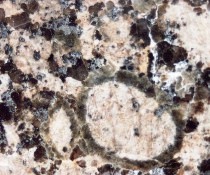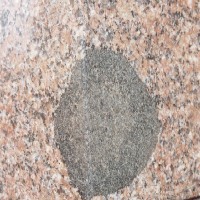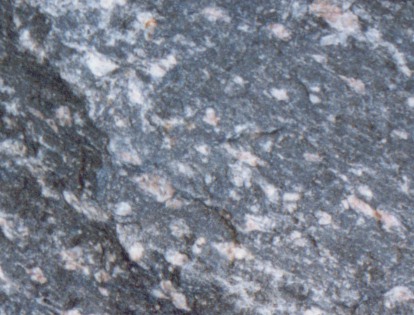Mike
Horne FGS
Describing Rocks
What is the general colour of
the rock?
Does a hand specimen feel heavier
than it looks?
What are the minerals in it?
What
percentage is there of each major mineral?
What shapes are the crystals or
grains?
What size are the crystals or grains?
Are
they all the same size?
In Sedimentary rocks:-
Is the
cement the same mineral as the clasts?
Are there any fossils or
microfossils?
Textures:
In Igneous Rocks:-
Amygdaloidal - with filled gas bubbles
Aphanitic - grains too small to be
distinguished with the naked eye.
Orbicular - rounded growths due to
reheating as the crystal has grown. For example Rapakivi texture plagioclase in
orthoclase as seen in Orbicular Granite (a.k.a. Baltic Brown) as seen on many
TSB banks; or Ophitic texture 'augite' enclosing plagioclase.

Phaneritic - grains can be seen
with the naked eye.
Poikolitic - small crystals enclosed within a larger
crystal
Porphyritic - larger crystals (=Phenocrysts) in a
finer grained groundmass
Spherulitic - a mass of radiating
crystals.
Vesicular - with gas bubbles
xenoliths -
inclusions of 'country rock'

In Metamorphic Rocks:-
Augens - lens shaped
crystals

Cleavage - a tendency for the
rock to split in a particular direction, because of the alignment of the
minerals [different from the cleavage within the crystals].
Gneissose -
a layering of coarse grained minerals, often into light and dark bands.
Granoblasic
- grains of roughly equal size
Idioblastic - well developed
crystals
Maculose - a spotty texture = "spotted rock"
Poikoblastic - small crystals enclosed within a larger crystal
Porphyroblastic - containing larger crystals (=porphyroblasts) in a finer
grained groundmass.
Schistose - parallel orientation of the mica grains
Relict
structure- relics of an original texture enclosed in a metamorphic mineral as it
has grown; may have an 'S' or 'Z' shape if the crystal has rotated during
growth.
Xenoblastic - irregular shaped crystals
In Sededimentary rocks:
Arenaceous
- Sandstones (1/16 to 2 mm grain size)
Argiallaceous - smaller grain size
than sandstones - e.g. siltstones, mudrocks and clays.
Graded
bedding - Clasts sorted by size within a bed
Grain size
- size of the clasts, measured on a scale from Clay (under 4 microns) up to
Boulders (greater than 256 mm)
Grain supported - clasts touching
(the opposite of matrix supported)
Matrix supported - clasts not
touching, supported in a groundmass of finer material.
Ooliths -
rounded particles of limestone looking like fish eggs.
Pellets -
fish poo.
Poorly sorted [= immature] - Clasts not the same shape
and size
Rounding - the degree of rounding of the clasts from
'well rounded' to 'very angular'
Rudaceous - coarser grained rocks -
e.g. conglomerates, breccias and tillites
Till = Boulder Clay - a mixture of
different sized clasts in clay left behind by a glacier.
Well sorted
[= mature] -Clasts the same shape and size
Pyroclastic or Volcaniclastic-
formed from shards of volcanic ash = tuff
copyright Mike Horne - October 2016
Hull Geological Society Home Page
Geology Courses Homepage


